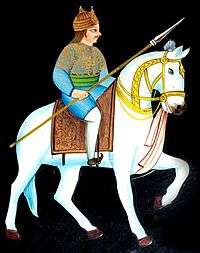Musunuri Nayakas
| Musunuri dynasty | |
|---|---|
| 13th century–14th century | |
| Capital | Warangal |
| Government | Monarchy |
| History | |
• Established | 13th century |
• Disestablished | 14th century |
The Musunuri Nayakas were warrior kings of 14th-century South India who were briefly significant in the region of present-day Andhra Pradesh and Telangana.
Origins
The Musunuri Nayakas were warrior chieftains in the Kakatiya army, who regained Andhradesa in 1326 from the Delhi Sultanate in the aftermath of the Kakatiya defeat.[1]
Some Andhra historians state that Musunuri Nayakas belonged to the Kamma caste group.[2][3] However, the modern castes of Andhra region did not originate until the late stages of the Vijayanagara Empire.[4]
Opposition to Turks
After the fall of the Kakatiyas, their empire was annexed by the Delhi Sultanate and Warangal was renamed "Sultanpur". Ulugh Khan remained as the governor of the region for a short period, until he was recalled to Delhi to succeed Muhammad bin Tughluq in 1324. A former Kakatiya commander, Nagaya Ganna Vibhudu, now renamed Malik Maqbul, was appointed as the governor of the region.[5] However, the Tughluq hold over the erstwhile Kakatiya kingdom was tenuous and a number of local chieftains seized effective power.[6]
In 1330, Musunuri Prolaya Nayaka published the Vilasa grant, a copper-plate grant near Pithapuram, in which he bemoaned the devastation of the Telugu country brought about by the Turks and attempted to legitimise himself as the rightful restorer of order.[7] His successor, Musunuri Kapaya Nayaka (r. 1333–1368), led a rebellion against the Tughluqs, driving them out of Warangal in 1336. According to the Kaluvacheru grant in AD 1423 of Rani Anitallidevi of Rajhmundry of the Panta Reddi clan of Kondavidu Reddy dynasty, Kapaya Nayaka was assisted by 75 Nayakas, including Prolaya Vema Reddi, the founder of the Reddy dynasty.[8]
Kapaya Nayaka ruled over Telangana until 1368. Upon his death, the allied Nayakas are said to have returned to their own towns.[9] Despite his opposition to the Turks, Kapaya Nayaka continued using the Kush Mahal built by the Turks in Warangal and adopted the Persianised title "Sultan of the Andhra country". In 1361, he gifted to the Bahmani Sultan Mohammed Shah I the Turquoise Throne as part of a treaty agreement.[10]
Reign
Little is known of Prolaya Nayaka or indeed any of the Musunuri family; they are often described as "obscure".[11][12] As uncertain as his rise were the methods that enabled some limited amount of success for the venture, which saw the rebels defeating the Delhi Sultanate's armies in some battles and disrupting their cohesion in the region. The nobles were able to assert control in the Godavari area, over which Prolaya Nayaka became the ruler from 1325 until his death in 1333. He left no children and was succeeded by a cousin, Kapaya Nayaka, who governed until 1368 and attempted to further expand his rule. He took control of Warangal from Malik Maqbul in 1336 and thus also of a wider swathe of eastern Telangana that was governed from there. He also tried to support other rebels in the surrounding areas, although in the case of aid given to Alauddin Bahman Shah, the outcome was that his fellow rebel turned on him. Several military engagements with Bahaman Shah followed over a period of years, during which Kapaya Nayaka had to cede various forts and territories. His weakened position was exploited by the Reddis and the Velamas, the latter of whom caused his death in battle at Bhimavaram and ended the period of the Musunuri family.[13][14]
References
Notes
Citations
- ↑ Devi, V. Yashoda (1975), After the Kākatīyas, Andhra Pradesh Sahitya Akademi
- ↑ Prasad D. "History of the Andhras upto 1565 A. D." 1988, P. 168
- ↑ History of Andhras, B. S. L. Hanumantha Rao
- ↑ Talbot 2001, p. 86.
- ↑ Wagoner & Rice 2001, p. 78.
- ↑ Eaton 2005, pp. 26-27.
- ↑ Talbot 2001, p. 178; Eaton 2005, pp. 26–27; Chattopadhyaya 1998, pp. 57–59
- ↑ Prasad 1988, p. 173.
- ↑ Talbot 2001, p. 178.
- ↑ Eaton 2005, p. 50.
- ↑ Talbot (2001), p. 177
- ↑ Eaton (2005), pp. 26-28
- ↑ Prasad (1988), pp. 168-172
- ↑ Talbot (2001), pp. 177-182
Bibliography
- Chattopadhyaya, B. D. (1998), Representing the Other? Sanskrit Sources and the Muslims, New Delhi: Manohar, ISBN 8173042527
- Eaton, Richard M. (2005), A Social History of the Deccan: 1300–1761, Cambridge University Press, pp. 15–16, ISBN 978-0-52125-484-7
- Prasad, J. Durga (1988), History of the Andhras up to 1565 AD, P. G. Publishers
- Talbot, Cynthia (2001), Pre-colonial India in Practice: Society, Region, and Identity in Medieval Andhra: Society, Region, and Identity in Medieval Andhra, Oxford University Press, ISBN 978-0-19803-123-9
- Wagoner, Phillip B.; Rice, John Henry (2001), "From Delhi to the Deccan: Newly Discovered Tughluq Monuments at Warangal-Sult̤ānpur and the Beginnings of Indo-Islamic Architecture in Southern India", Artibus Asiae, 61 (1): 77–117, JSTOR 3249963
Further reading
- Devi, V. Yashoda (1975), After the Kākatīyas, Andhra Pradesh Sahitya Akademi
- A history of South India from prehistoric times to the fall of Vijayanagar, K. A. Nilakanta Sastri, Oxford Univ. Press, 1955.
- Subrahmanyam, Sanjay (1998). "Hearing Voices: Vignettes of Early Modernity in South Asia, 1400–1750". Daedalus. 127 (3): 75–104. JSTOR 20027508. (Subscription required (help)).

